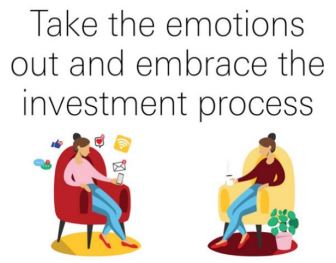
16 Jul 2023
Neha Sahni
Director, Global Market Strategist, HSBC Global Private Banking and Wealth
Behavioural finance is a field of study that focuses on psychological factors driving investors’ decisions in the financial markets. By blending finance and psychology, behavioural finance tries to identify biases that lead investors to make irrational investment decisions and demonstrates how difficult it can be to get rid of these human follies even when they are told that their choices aren’t optimal. Several behavioural finance studies show that financial markets can be influenced by investor sentiment, which may sometimes be too optimistic or pessimistic, and deviate from underlying fundamentals.

FOMO Fear of Missing out is often: |
JOMO Joy of Missing out is when: |
|---|---|
|
|
FOMO Fear of Missing out is often: |
||
|---|---|---|
| JOMO Joy of Missing out is when: |
||
FOMO Fear of Missing out is often: |
|
|
| JOMO Joy of Missing out is when: |
|
|
FOMO Fear of Missing out is often: |
||
| JOMO Joy of Missing out is when: |
| Key behavioral bias | How to address these biases |
| Anchoring and adjustment bias | 1. Don’t try to address all the biases at once. Figure out which top two or three biases impact your investment decisions the most and try to continuously keep those biases/behaviours in check. 2. The best way to avoid behavioural biases is to take emotions out of one’s investment decisions by having an investment “pre-commitment” in place . A rule-based strategies like Strategic Asset Allocation (SAA) and Tactical Asset Allocation (TAA) are known to statistically deliver positive outcomes over the long term. Removing discretion from day-to-day decision making around trading and investing reduces the chance of trading on impulse or be driven by fear and greed. 3. Stick to their investment process/strategy over the long run. Doing so should protect investors from their conscious and unconscious behavourial biases and deliver the best possible investment outcomes. |
| Overconfidence bias | |
| Investor myopia | |
| Herd behavior | |
| Disposition effect | |
| Status-quo bias |
| Key behavioral bias | Anchoring and adjustment bias | Anchoring and adjustment bias |
|---|---|---|
| How to address these biases |
1. Don’t try to address all the biases at once. Figure out which top two or three biases impact your investment decisions the most and try to continuously keep those biases/behaviours in check. 2. The best way to avoid behavioural biases is to take emotions out of one’s investment decisions by having an investment “pre-commitment” in place . A rule-based strategies like Strategic Asset Allocation (SAA) and Tactical Asset Allocation (TAA) are known to statistically deliver positive outcomes over the long term. Removing discretion from day-to-day decision making around trading and investing reduces the chance of trading on impulse or be driven by fear and greed. 3. Stick to their investment process/strategy over the long run. Doing so should protect investors from their conscious and unconscious behavourial biases and deliver the best possible investment outcomes. |
1. Don’t try to address all the biases at once. Figure out which top two or three biases impact your investment decisions the most and try to continuously keep those biases/behaviours in check. 2. The best way to avoid behavioural biases is to take emotions out of one’s investment decisions by having an investment “pre-commitment” in place . A rule-based strategies like Strategic Asset Allocation (SAA) and Tactical Asset Allocation (TAA) are known to statistically deliver positive outcomes over the long term. Removing discretion from day-to-day decision making around trading and investing reduces the chance of trading on impulse or be driven by fear and greed. 3. Stick to their investment process/strategy over the long run. Doing so should protect investors from their conscious and unconscious behavourial biases and deliver the best possible investment outcomes. |
| Key behavioral bias | Overconfidence bias | Overconfidence bias |
| How to address these biases | ||
| Key behavioral bias | Investor myopia | Investor myopia |
| How to address these biases | ||
| Key behavioral bias | Herd behavior | Herd behavior |
| How to address these biases | ||
| Key behavioral bias | Disposition effect | Disposition effect |
| How to address these biases | ||
| Key behavioral bias | Status-quo bias | Status-quo bias |
| How to address these biases |




This document is prepared by The Hongkong and Shanghai Banking Corporation Limited (‘HBAP’), 1 Queen’s Road Central, Hong Kong. HBAP is incorporated in Hong Kong and is part of the HSBC Group. This document is distributed by HSBC Bank Canada, HSBC Bank (China) Company Limited, HSBC Continental Europe, HBAP, HSBC Bank (Singapore) Limited, HSBC Bank (Taiwan) Limited, HSBC Bank Malaysia Berhad (127776-V) / HSBC Amanah Malaysia Berhad (807705-X), The Hongkong and Shanghai Banking Corporation Limited, India, HSBC Bank Middle East Limited, HSBC UK Bank plc, HSBC Bank plc, Jersey Branch, and HSBC Bank plc, Guernsey Branch, HSBC Private Bank (Suisse) SA, HSBC Private Bank (Suisse) SA DIFC Branch, HSBC Private Bank Suisse SA, South Africa Representative Office, HSBC Financial Services (Lebanon) SAL, HSBC Private banking (Luxembourg) SA and The Hongkong and Shanghai Banking Corporation Limited (collectively, the “Distributors”) to their respective clients. This document is for general circulation and information purposes only. This document is not prepared with any particular customers or purposes in mind and does not take into account any investment objectives, financial situation or personal circumstances or needs of any particular customer. HBAP has prepared this document based on publicly available information at the time of preparation from sources it believes to be reliable but it has not independently verified such information. The contents of this document are subject to change without notice. HBAP and the Distributors are not responsible for any loss, damage or other consequences of any kind that you may incur or suffer as a result of, arising from or relating to your use of or reliance on this document. HBAP and the Distributors give no guarantee, representation or warranty as to the accuracy, timeliness or completeness of this document. This document is not investment advice or recommendation nor is it intended to sell investments or services or solicit purchases or subscriptions for them. You should not use or rely on this document in making any investment decision. HBAP and the Distributors are not responsible for such use or reliance by you. You should consult your professional advisor in your jurisdiction if you have any questions regarding the contents of this document. You should not reproduce or further distribute the contents of this document to any person or entity, whether in whole or in part, for any purpose. This document may not be distributed to any jurisdiction where its distribution is unlawful. The following statement is only applicable to HSBC Bank (Taiwan) Limited with regard to how the publication is distributed to its customers: HSBC Bank (Taiwan) Limited (“the Bank”) shall fulfill the fiduciary duty act as a reasonable person once in exercising offering/conducting ordinary care in offering trust services/ business. However, the Bank disclaims any guarantee on the management or operation performance of the trust business.
© Copyright 2023. The Hongkong and Shanghai Banking Corporation Limited, ALL RIGHTS RESERVED.
No part of this document may be reproduced, stored in a retrieval system, or transmitted, on any form or by any means, electronic, mechanical, photocopying, recording or otherwise, without the prior written permission of The Hongkong and Shanghai Banking Corporation Limited.